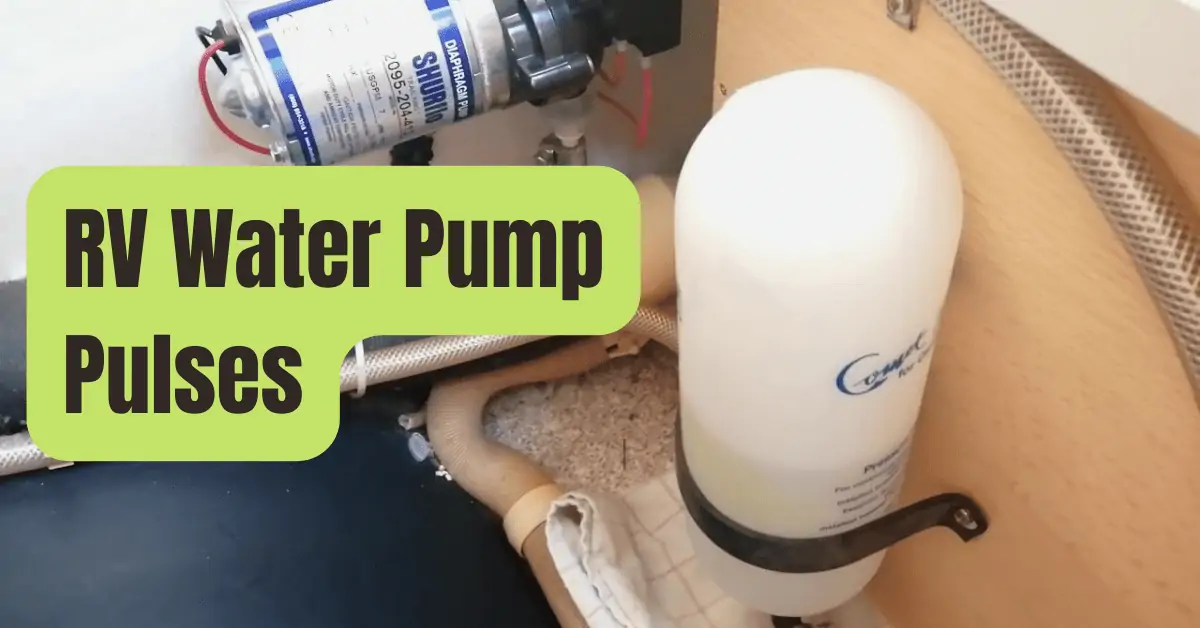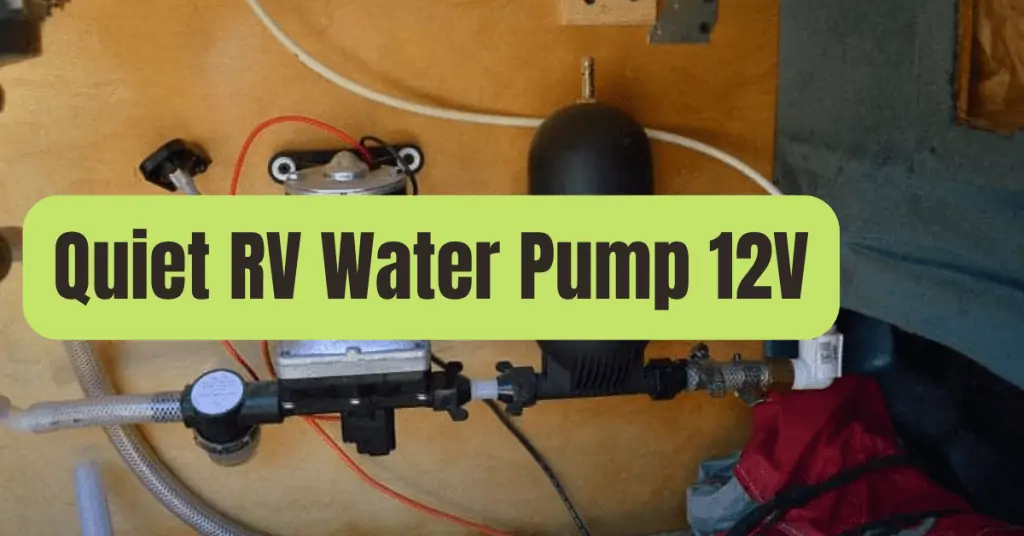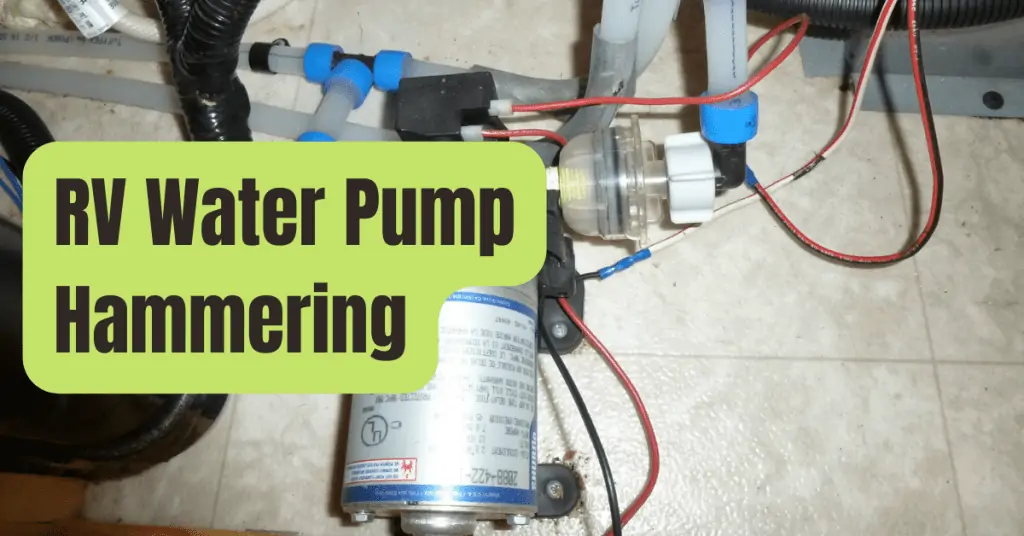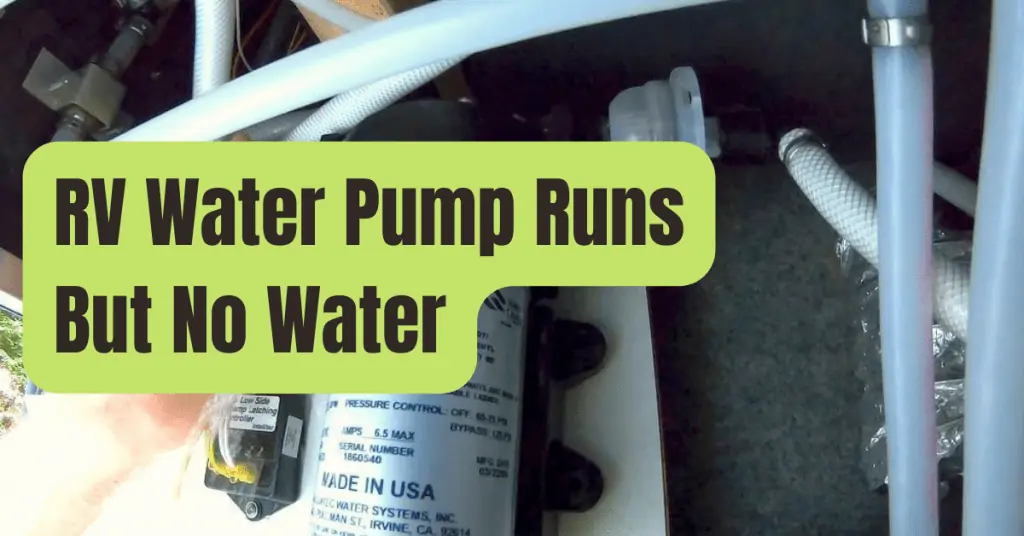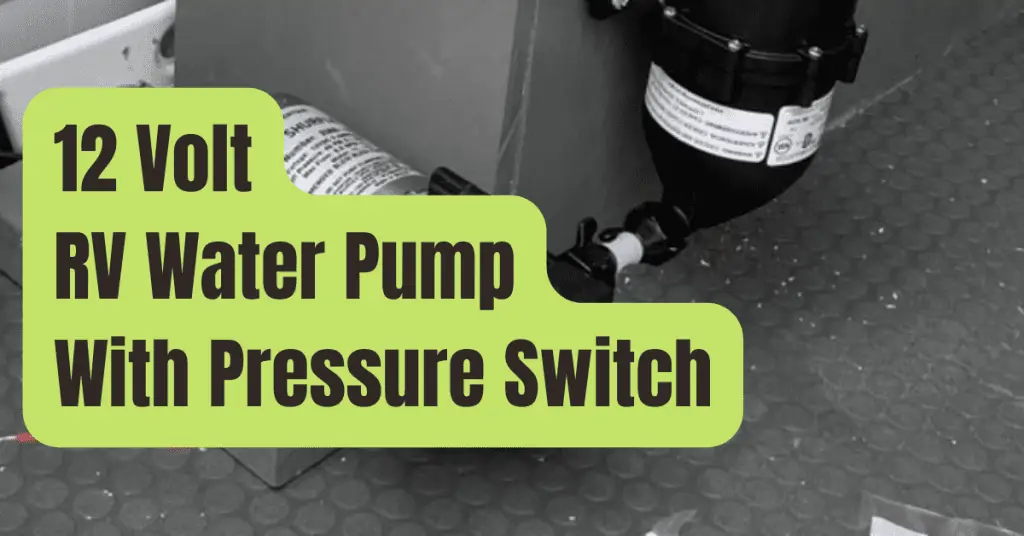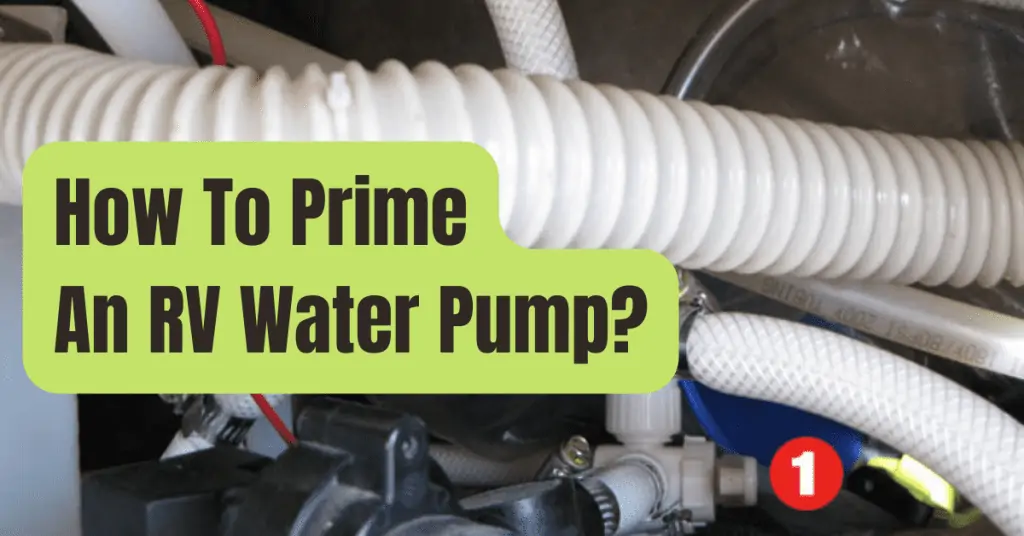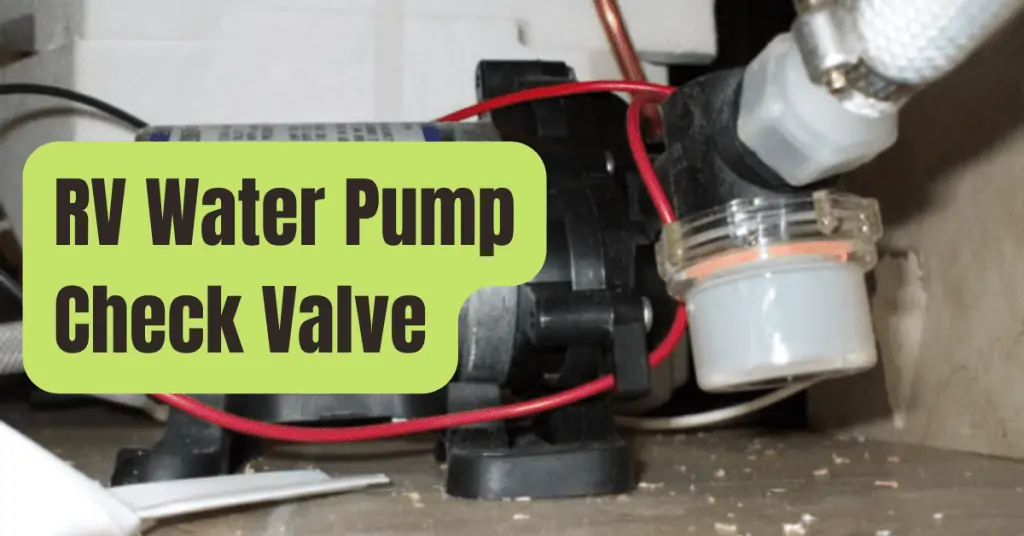The water pump in your RV is an amazing piece of equipment.
It does not matter where you are while you are using your rig; water may still flow through the plumbing.
Even if you are camping in the middle of nowhere in the woods, in the middle of nowhere in the desert, or on the beach, this will give you with all the water-related creature comforts of home in your RV.
However, if the water pump in your RV is making pulsating noises, this may not only make it difficult for you to take a great, hot shower, but it may also indicate that there is an issue with the plumbing system in your rig.
And since this issue causes the water flow to pulsate up and down in response to the cycling of the pump, it may result in a very uncomfortable experience…
particularly when one is showering.
The temperature of the water is subject to change as a result of the lulls and surges in the current, which may sometimes be very significantly.
And THAT is something no one wants!
Now that we know what a pulsating RV water pump might mean, let’s have a look at how to repair it!
Why Does the Water Pump in My Recreational Vehicle Pulse?
To begin, let’s make a distinction between the terms “cycling” and “pulsing” when referring to the water system in our RV.
The turning on and off, or “cycling,” of the water pump as it performs its function is quite normal.
Unless we are running water at a very high flow rate, in which case the pump would operate constantly, the pump will cycle on and off as it supplies a flow of water.
If we are running water at an extremely high flow rate, however, the pump will run continually.
When you stop and give it some thought, you’ll realize that this on-off cycle is pretty much the norm.
This is due to the fact that we make the most use of our water pump while we are free-camping, since connecting to a campground’s municipal water supply eliminates the need for the pump in that setting.
But when we’re out in the wilderness boondocking, we don’t usually have the water running at a very fast pace.
The sound of the water pump cycling on and off is far more common than the sound of the pump running constantly, therefore hearing the water pump run continually is a very unusual sound to hear.
This is because, by definition, this is what occurs at the lower flow rates that the pump is most usually used for.
As a result, this is why it is the case.

When we are dry camping and utilizing the onboard water pump of our rig, we should only hear the pump operating when we are really requesting water from a sink faucet, shower, or toilet.
However, even when the pump is cycling on and off at flow rates ranging from low to moderate, the water flow itself should be rather consistent.
The water flow should not have a discernible up and down “pulsing,” since this would be unnatural and be an indication of a problem, which is exactly what we are going to go through today.
When your RV is attempting to maintain a consistent water pressure throughout the operation of the system, you will be able to hear the water pump cycling on and off.
When you use a portion of your plumbing system, the quantity of water flowing through the system is reduced, which results in a lower pressure overall.
The water pump in your vehicle is responsible for maintaining the water pressure throughout the system by turning on and off at regular intervals.
In addition, the water pump in your RV is intended to only operate if the plumbing is being used.
This indicates that the only time you should be able to hear your water pump is when you are actively using the water in some part of your RV…
in a sink, a shower (indoor or outdoor), the toilet, the ice machine, and other similar locations.
The only way for water to get to your faucets when you’re not linked up to a pressurized supply of “city” water is for you to have a water pump installed.
To reiterate, it only operates while it is in the process of actually completing that delivery.
As soon as you turn off each of the faucets, you shouldn’t be able to hear the running of your water pump anymore.
It is crucial to keep this in mind since, should an issue arise with your plumbing system, such as a leak in the water supply, it may assist you in locating and diagnosing the source of the problem.
Therefore, you’ll be able to hear the water pump turn on whenever you run the water in any part of your RV.
It is, in essence, making up for the decrease in pressure that has occurred throughout the system.
The quicker the water is pushed through the pipe, the quicker the pump will cycle.
When the water is turned on, the pump will operate continuously if you are using the maximum amount of available water pressure.
If you hear the pump turn on even if you are not using any water, this may be a sign that there is a leak somewhere in the system.
Keep in mind that the only time you should hear your water pump running is if you are requesting water from another location on the RV.

It’s possible that you have a leak somewhere in your RV’s plumbing system if you hear your water pump making pulsating noises even if you’re not using any water in your recreational vehicle (this includes your outdoor shower).
It is also possible that it is an indication of a faulty component inside the water pump itself.
Components in the water pump may shatter, for instance, if a recreational vehicle (RV) hasn’t been adequately winterized before temperatures drop below freezing.
If there is a problem with your water pump, you could hear it cycling (or perhaps running continuously) even though you aren’t requesting any water at the moment.
In point of fact, if you do not winterize your recreational vehicle (RV) or do not winterize it correctly, you may discover that you have a variety of plumbing issues come springtime.
Other components of the water pump, such as valves, might break, and the pipelines themselves can crack or burst if they are not properly maintained.
This is the reason why we have written a lot of tutorials on how to properly winterize your RV.
Please have a look at our advice on winterizing an RV if this is your first time camping or preparing your RV for the winter.
Check out our page on blowing out RV water lines vs antifreeze if you are unsure which technique of winterizing your recreational vehicle you would want to employ.
In addition, we have a post that is solely devoted to the process of winterizing an RV with the use of an air compressor.
And last but not least, if you would like a personal step-by-step tutorial to winterizing the water lines in your RV using an air compressor, we have it available for you in the form of a video:
The water pump in your RV can be pulsating for another reason, and that reason is because the pressure switch isn’t adjusted correctly.
To begin and end its cycle, the water pump in your RV is controlled by a pressure switch.
Pulsing may occur if the switch is not set to the appropriate position.
There is a chance that you can change the pressure setting.
Water pumps come in a wide variety of kinds and models; however, not all of them are adjustable.
However, a good number of them are, so let’s get right into adjusting the pressure setting on your water pump.
How Do You Fix an RV Water Pump That Is Pulsating?
There are a few various approaches to taking care of the problem, and each one is contingent on the root cause of the pulsing that your RV water pump is experiencing.
Let’s get started with a walkthrough on how to change the pressure setting on a water pump.
Adjust the Pressure Setting on Your Recreational Vehicle’s Water Pump.
Find your water pump and make a note of the brand and model; the methods for modifying the pressure settings will be somewhat different depending on the kind of pump you have.
Once you have found your water pump, take a note of the brand and model.
You will get instructions pertaining to the three most popular brands, which are Flojet, Shurflo, and Seajet.
However, it is essential to keep in mind that not all brands and types of pumps are equipped with an adjustment mechanism.
Adjusting the cut-off point of the pump is essentially what we are doing in this particular step here.
Remove the cover plate from the pressure switch on any kind of pump before proceeding with the repair.
You should be able to detect a screw with a Phillips head (also known as a cross-head) resting in that location between two electrical connections.
Depending on what you’re attempting to do, you’ll be rotating the screw in either the clockwise OR counterclockwise direction.
In order to reduce the pressure at which the pump shuts off You only need to loosen the screw a little bit till you obtain the effect you want.
(You will move the knob clockwise to raise the cut-off pressure in order to halt the cycle, and you will turn the knob counterclockwise in order to decrease the cut-off pressure of the pump.)

It just so happens that this is a Seaflo water pump, but the design of other manufacturers of 12V water pumps will be quite comparable.
The direction that the arrow points in shows where the pressure switch that may be adjusted is located.
In most cases, a screwdriver with a Phillips head is required to make the necessary adjustment.
(Photo credit: Seaflo through Amazon)
It is essential to notice that the screw does not in any way impact the flow rate of the liquid.
It only modifies the pressure at the cut-off point.
In most cases, there is a sweet spot for each system.
Additionally, as the pump ages, the tension of the spring may sometimes vary, and a little adjustment may be all that is required to transform the water pump from one that pulses to one that does not.
The objective here is to switch off the water supply and make sure that the pump shuts off within around ten seconds after you have adjusted the screw to the point where it produces a constant flow from the pump.
When you have accomplished this objective, you will have found the optimal setting for your pump.
Adjusting the Pressure Setting on a Flojet Water Pump: Step-by-Step Instructions
- To remove the cover plate from the pressure switch located on your water pump, you will need a screwdriver with a Phillips head.
- Please take note of the screw with a Phillips head that is located in between the two electrical connections.
- Prepare to rinse off in the shower.
- To raise the cut-off pressure, turn the screw in the clockwise direction. Put the shower head on pause. If the pump continues to operate after the screw has been turned slightly counterclockwise, the pump won’t be able to be stopped.
Adjusting the Pressure Setting on a Shurflo Water Pump: Step-by-Step Instructions
- Find the housing that is attached to the pipe at the very end of your water pump. It is expected that the housing would have two red wires emerging from it. There should be an Allen screw in that location (sometimes called a hex-key screw).
- Prepare to rinse off in the shower.
- You may stop the cycle by turning the screw in a clockwise direction with an Allen wrench. (Shurflo suggests doing one and a quarter revolutions at a time.)
- To do the test, turn off the shower. If you switch off the shower but the pump continues to run, this indicates that the Allen screw has been moved beyond its normal range of motion. Reduce the pressure by rotating the screw in the anti-clockwise direction until the pump stops moving.
Adjusting the Pressure Setting on a Seaflo Water Pump: Step-by-Step Instructions
- Find the housing that is attached to the pipe at the very end of your water pump. It is expected that the housing would have two red wires emerging from it. There should be an Allen screw in that location (sometimes called a hex-key screw).
- Prepare to rinse off in the shower.
- To halt the cycle, turn the pressure adjustment screw so that it is facing clockwise.
- To do the test, turn off the shower. If the pump does not switch off automatically, spin the screw a little bit in the counterclockwise direction until it does.
Mount an Accumulator Tank in your system.
Accumulator tanks are used in recreational vehicles to help maintain a consistent water pressure throughout the plumbing system, which in turn makes it easier for the water pump to operate.
A pressurized bladder is housed inside of a plastic reservoir that serves as an accumulator tank.
Because of the bladder, the accumulator tank is able to absorb and control the system’s extreme high and low pressures.
In order to keep the overall system pressure at a consistent level, the water pump that you are using will cause a fluctuation in the pressure that is contained inside the bladder.
This should help reduce the highs and lows in water flow that might occur when the pump is spinning in your recreational vehicle (RV).
Because an accumulator tank may lessen the amount of cycling that your pump performs and absorb pressure reductions that result from running the tap, it can also lower the amount of effort that your pump has to put in.
The longevity of your water pump may be increased as a result of this.
An intriguing fact, particularly for those of us who like to free camp: In order to perform its function, an accumulator tank relies only on the compressed bladder, which does not call for any external power source.
An accumulator tank may help cut down on the amount of electricity that is used by your plumbing system since it cuts down on the length of time that your water pump is running.
A plumbing system may benefit from the addition of a small accumulator tank, which is easy to place anywhere on the pressured side of the system (that is, after the water pump).
Sale

SHURflo 182-200 Pre-Pressurized Accumulator Tank,Black, 9.1″ x 4.8″ x 3.8″
- Reduces the amount of pump cycling
- The water faucet’s pulsations are smoothed out.
Is There Anything Else That Could Be Causing My RV Water Pump to Pulsate?
The most typical cause of pulsating water flow from an RV water pump is a problem with the pressure sensor that is incorporated into the pump, either because it has been improperly adjusted or has failed entirely.
On the other hand, pulsing can also be an indication of any of the following:
#1. There Is A Leak In The Plumbing System Somewhere.
As was said before, this issue might arise from any part of the system, including the water pump itself, the pipes, a valve, or even a filter.
When there is a leak in the system, the water pump has trouble maintaining the pressure inside the system, which may create pulsing or steady running of the pump depending on the severity of the leak.
#2. Your Tank of Fresh Water Is Running Out Of Water
It’s possible that your recreational vehicle’s water pump is pulsating the flow of water because it’s attempting to compensate for what it perceives to be low pressure, but in reality, it’s merely laboring to pull water from an empty (or almost empty) tank.
#3. There is a Bottleneck in the System (Usually in a Filter)
Your water pump may get confused as a result of the inconsistent flow of water if the filter is blocked or if there is any other kind of obstruction in the system.
This is a simple problem to solve.
Check the water filter (or filters) in your system, and clean them if they need it.
Remember that there is nearly always a little inline filter on the side of the water pump that is responsible for taking in water.
Is It Possible for Me to Replace the Water Pump in My RV on My Own?
It is possible for you to repair or replace the water pump in your RV on your own.
Even the most reliable RV water pumps run the risk of breaking down after enough time and usage.
For more than 14 years, we made do with the same on-demand water pump.
However, when it stopped working, we were the ones to replace it.
It’s a simple do-it-yourself job.
In addition to this, we produced a film in which we illustrate the process of replacing an RV water pump as well as the method that we believe to be the most effective!
Have You Experienced Problems Caused by a Pulsating RV Water Pump?
Tell us in the space below under “Comments” how you fixed the problem if you’ve ever had an RV water pump that pulsed while you were using it.

